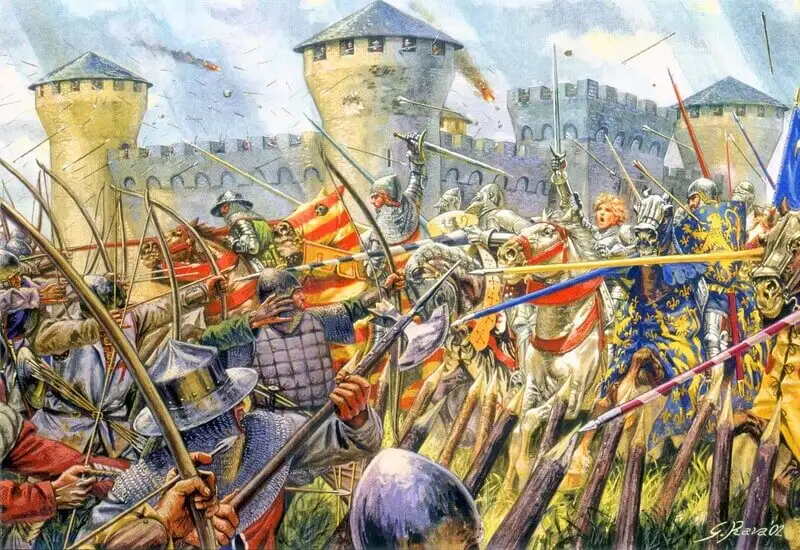The Battle of Red Cliffs, also known as the Battle of Chibi, stands as one of the most celebrated engagements in Chinese military history, marking a turning point in the Three Kingdoms period. Fought in 208–209 AD, this Chinese naval battle saw the Sun-Liu alliance, led by Sun Quan and Liu Bei, decisively defeat the formidable warlord Cao Cao. The Red Cliffs conflict, renowned for its innovative fire attack tactics led by Zhou Yu and Huang Gai, shaped the Han Dynasty collapse and the subsequent division of China into the Three Kingdoms.
This article explores the time, location, causes, course, casualties, and outcome of the Yangtze River battle, offering a detailed account for historians and enthusiasts of ancient Chinese warfare.
Time and Date of the Battle
The Battle of Red Cliffs occurred during the winter of 208–209 AD, with the main engagement likely taking place in December 208 or January 209 AD. Historical sources, such as the Records of the Three Kingdoms by Chen Shou, do not provide an exact date due to the extended campaign, but the decisive naval clash on the Yangtze River is traditionally dated to late 208 AD. The battle spanned several weeks, culminating in a critical confrontation that altered the course of the Three Kingdoms war.
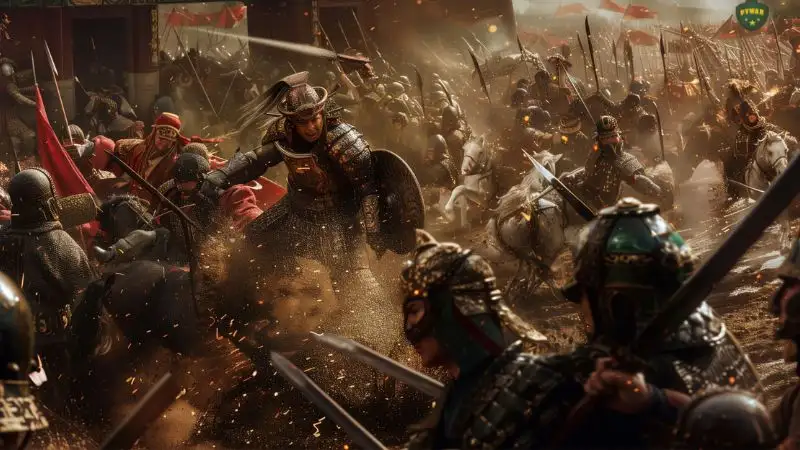
Location of the Battle
The Battle of Chibi was fought along the Yangtze River, near Red Cliffs (Chibi), in modern-day Hubei Province, China. The precise location remains debated, but historians generally place it near Chibi City, on the southern bank of the Yangtze, between Xiakou (modern Wuhan) and Fankou. The Red Cliffs campaign centered around the river’s strategic stretch, where steep, reddish cliffs provided a dramatic backdrop. Key sites included Wulin, where Cao Cao’s fleet was moored, and Huarong Pass, a narrow route used during the retreat. The Yangtze River conflict leveraged the river’s width and currents, making it a pivotal theater for naval battle tactics in ancient Chinese warfare.
Causes of the Conflict
The Battle of Red Cliffs was a culmination of tensions during the Eastern Han Dynasty’s decline, as the Han Dynasty collapse gave rise to the warlord era. Several factors precipitated this monumental clash:
- Cao Cao’s Unification Ambitions: Cao Cao, a powerful warlord controlling northern China, sought to unify the fragmented Han Dynasty under his rule. By 208 AD, he had conquered much of the north, including Jingzhou, and aimed to subdue the southern warlords Sun Quan of Eastern Wu and Liu Bei of Shu Han to complete his conquest.
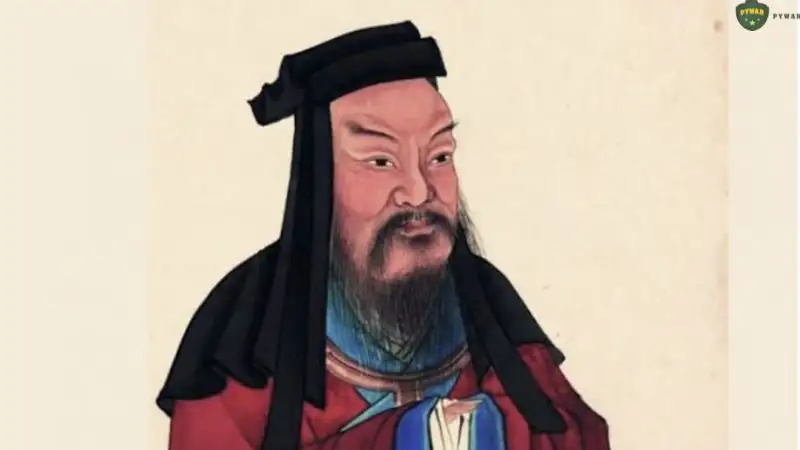
- Sun Quan and Liu Bei’s Resistance: Sun Quan, ruler of the southeastern Eastern Wu, controlled the lower Yangtze region, while Liu Bei, a claimant to the Han imperial line, sought to establish his base in Jingzhou. Both faced existential threats from Cao Cao’s expansion, prompting the formation of the Sun-Liu alliance to counter his dominance.
- Strategic Importance of Jingzhou: Jingzhou, a fertile and strategically vital province along the Yangtze, was a key target for Cao Cao. Its capture in 208 AD gave him a foothold to invade the south, threatening Wu and Shu. The Three Kingdoms war hinged on control of this region, making a confrontation inevitable.
- Political and Ideological Rivalries: Cao Cao’s authoritarian rule and claim to the Han mandate clashed with Sun Quan and Liu Bei’s aspirations to preserve their autonomy and legitimacy. The warlord conflicts of the period were fueled by competing visions for China’s future, with the Sun Quan-Liu Bei victory at Chibi preserving regional independence.
These factors set the stage for the Chibi naval battle, as Cao Cao’s southward campaign provoked a desperate defense by the allied southern forces.
Course of the Battle
The Battle of Red Cliffs was a masterclass in military tactics of Three Kingdoms, combining deception, fire ship strategy, and naval coordination. The Sun-Liu alliance, under the strategic leadership of Zhou Yu and Zhuge Liang, outmaneuvered Cao Cao’s numerically superior forces. The battle unfolded as follows:
Prelude and Strategic Planning
In late 208 AD, Cao Cao led an army claimed to number 800,000 (likely exaggerated, with modern estimates of 200,000–240,000) south from Jingzhou, capturing Xiakou and establishing a base at Wulin on the northern bank of the Yangtze River. His massive fleet, comprising captured Jingzhou ships and northern vessels, was moored opposite the Red Cliffs. Sun Quan, with 50,000 troops, and Liu Bei, with 20,000, formed an alliance, stationing their forces at Fankou and Xiakou. Zhou Yu, Wu’s commander, and Zhuge Liang, Liu Bei’s strategist, devised a plan to exploit Cao Cao’s weaknesses: his troops’ unfamiliarity with naval warfare and susceptibility to disease in the south.
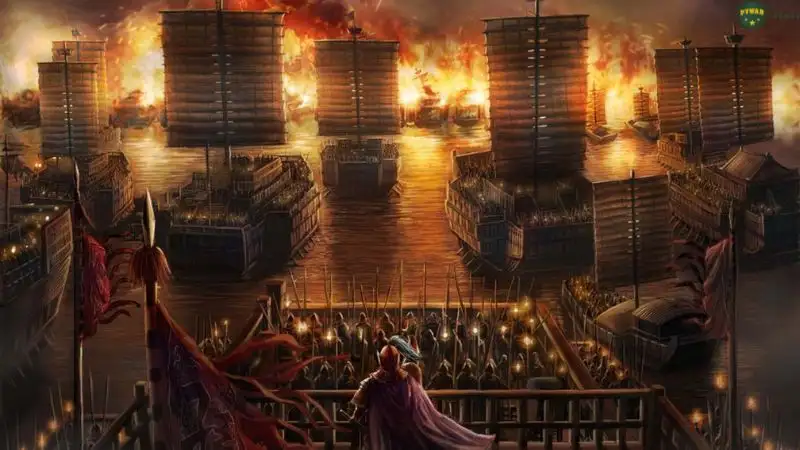
Initial skirmishes at Wulin saw Cao Cao’s forces, plagued by illness (possibly typhoid or malaria), suffer minor defeats. Zhuge Liang proposed a psychological ploy, sending a false defection letter from Huang Gai, a Wu general, to Cao Cao, claiming he would surrender with ships. This set the stage for the fire attack tactics.
The Fire Attack
On the night of the decisive clash, likely in December 208 AD, Huang Gai executed the fire ship strategy. Under the pretext of defecting, he sailed a squadron of ships laden with flammable materials—pitch, straw, and oil—toward Cao Cao’s fleet at Wulin. A southeast wind, predicted by Zhuge Liang, propelled the fire ships. As they neared, Huang Gai’s men ignited the vessels, which crashed into Cao Cao’s tightly packed fleet. The flames, fanned by the wind, spread rapidly, destroying hundreds of ships and setting the northern camp ablaze. The Yangtze River conflict turned chaotic as Cao Cao’s troops, unaccustomed to naval combat, were thrown into disarray.
Seizing the moment, Zhou Yu led a coordinated assault with Wu’s navy, supported by Liu Bei’s land forces. The allied fleet crossed the Yangtze, engaging Cao Cao’s disorganized troops in close combat. The fire and subsequent attacks decimated Cao Cao’s navy, forcing a retreat toward Huarong Pass, a narrow, muddy route exacerbated by heavy rains.
The Retreat and Pursuit
At Huarong Pass, Zhuge Liang had prepared an ambush, but accounts vary on its execution. The Romance of the Three Kingdoms, a later novel, dramatizes Zhuge Liang sparing Cao Cao to prolong the Three Kingdoms division, though historical records suggest Cao Cao’s forces were harassed but escaped due to the allies’ limited numbers. Cao Cao fled north to Jiangling, abandoning his southern ambitions.
Aftermath
The Sun Quan-Liu Bei victory secured Jingzhou for the allies, with Liu Bei gaining control of southern Jingzhou and Sun Quan consolidating Eastern Wu. Cao Cao’s defeat halted his unification efforts, cementing the tripartite division of China into Eastern Wu, Shu Han, and Cao Cao’s Wei. The Red Cliffs campaign demonstrated the power of strategic alliances and innovative tactics in ancient Chinese warfare.
Casualties
Precise casualty figures for the Battle of Red Cliffs are uncertain due to exaggerated historical accounts and lack of detailed records. Estimates based on the Records of the Three Kingdoms and modern scholarship include:
- Cao Cao’s Forces: Likely 50,000–100,000 casualties, including those killed in the fire attack, drowned in the Yangtze River, or lost during the retreat through Huarong Pass. Disease and desertion further depleted Cao Cao’s army, with some sources claiming half his forces perished.
- Sun-Liu Alliance: Approximately 5,000–10,000 casualties, as the allied forces suffered fewer losses due to their strategic advantage and smaller, more cohesive army. The fire ship strategy minimized direct combat losses for Wu and Shu.
The Cao Cao’s defeat was catastrophic, with the destruction of his fleet and loss of Jingzhou marking a significant setback.
Who Won the Battle of Red Cliffs?
The Sun-Liu alliance, led by Sun Quan and Liu Bei, won the Battle of Red Cliffs. Their victory, orchestrated by Zhou Yu’s strategy and Huang Gai’s fire attack, decisively repelled Cao Cao’s invasion, preserving the autonomy of Eastern Wu and Shu Han. The Chibi naval battle halted Cao Cao’s dream of unifying China, ensuring the Three Kingdoms period’s tripartite division. This Sun Quan-Liu Bei victory not only secured strategic territories but also demonstrated the effectiveness of naval battle tactics and alliances in the warlord era, shaping the course of Chinese military history.
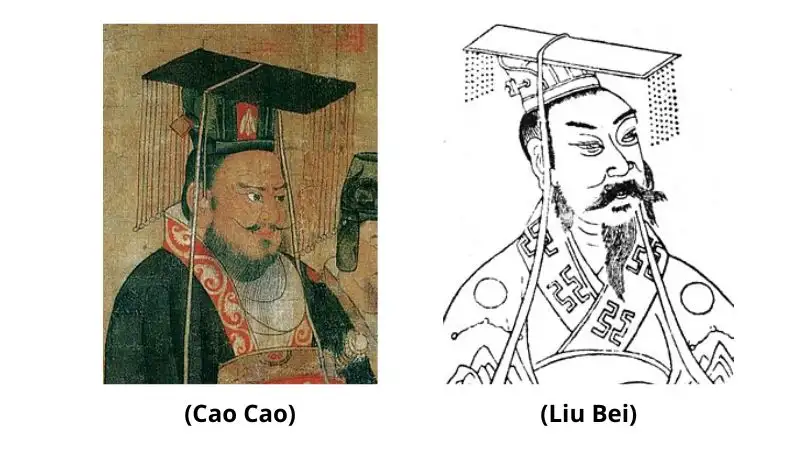
Conclusion
The Battle of Red Cliffs, fought in 208–209 AD along the Yangtze River, was a defining moment in the Three Kingdoms period, showcasing the brilliance of Zhou Yu, Huang Gai, and Zhuge Liang in defeating Cao Cao. The Red Cliffs conflict, driven by Cao Cao’s unification ambitions and the Sun-Liu alliance’s resistance, leveraged fire attack tactics to secure a stunning victory. With estimated casualties of 50,000–100,000 for Cao Cao and 5,000–10,000 for the allies, the battle preserved the independence of Eastern Wu and Shu Han, thwarting the unification of China under Wei.
The Battle of Chibi remains a legendary example of ancient Chinese warfare, immortalized in history and the Romance of the Three Kingdoms. For historians and enthusiasts, it offers profound insights into the strategic, political, and cultural dynamics of the Eastern Han Dynasty and the enduring legacy of the Three Kingdoms war.


